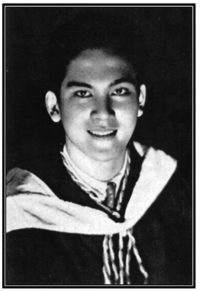All the way from Miyanoshita to Tokyo was marked by send-off, parties for men called to the colors. The school-children in the village were lined up at the tram station, singing at the top of their voices, for an excited spectacled youth with the usual banner slung over his shoulders. Apparently he was one of their teachers. In Odawara a group of students formed a ring and clapped and cheered in the approved American collegiate fashion; it seemed to fascinate the staring crowd of peasants on the platform, who would no doubt have been scandalized to know the spiritual affiliations with “enemy culture”. And so, all the way to Tokyo, we were accompanied by this obligatto of farewells, tearless, a little shrill, a little solemn. But the reservees had only these brief moments of glory; when the station bells rang their warnings, the singing, swaying, paper-flag-waving circles broke up amid bows a shade more profound than usual and more hurried, more submissive to the decree of fate. “Sayonara” — if it must be so. Then the reservees were lost and ignored in the crowded train and had to scramble for their seats like the rest of us.
But the people at home will be joining an army of their own, the “national volunteer force” with the premier as “commander- in-chief”. “All existing bodies wiil be dissolved and absorbed into it,” explains the Times. “It is believed that the force will be the backbone of all war activities such as munitions and foodstuffs production and transportation.” But nobody seems to know very clearly what it will be like.
